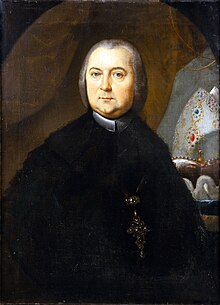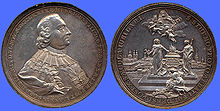Heinrich von Bibra



Heinrich (Karl Sigismund) von Bibra OSB (born August 22, 1711 in Schnabelwaid ; † September 25, 1788 in Fulda ) was Prince-Bishop and Abbot of Fulda as Heinrich VIII .
Life
education
The Fulda prince-bishop Heinrich von Bibra came from an old Franconian noble family and was the son of general Heinrich Karl von Bibra and his wife Maria Johanna Theresia nee. by Eyb (* 1685).
In 1725 he enrolled in the poetry class of the Bamberg Academy. After the ancestry had passed , the solemn revival took place on November 6, 1729 in the noble Benedictine convent of Fulda . On November 12, 1730 Bibra made his profession with the religious name Heinrich . On December 23, 1730 he received the tonsure and minor orders and on February 28, 1733 the subdeacon ordination in Fulda.
Ordinations and offices
Bibra received his theological training at home at the Fulda Benedictine monastery. Presumably in the summer of 1733 he moved to Rome for further studies . After his return he was ordained deacon on March 5, 1735 and a little later, on April 9, 1735, the ordination . With his ordination, the noble monk was given the option of one of the fifteen chapter passages in the bishopric. In 1750 he was accepted into the body. Prince Abbot Amand von Buseck named the new collegiate capital on August 22, 1751 superior of the convent, who took the place of abbot. As part of his interim government after the death of Prince-Bishop Buseck, Bibra received the office of forest president on December 22, 1756. In 1759, Prince-Bishop Adalbert II von Walderdorff made him president of the Hofrentkammer, the princely financial administration.
Episcopate
Bibra took over his bishopric during the turmoil of the Seven Years' War . After his election by the Fulda cathedral chapter on October 22, 1759 as the 83rd abbot of the monastery and third prince-bishop of Fulda, Bibra fled the royal seat, but returned whenever the situation allowed, in order to be able to carry out his duties. After the informative process carried out in Cologne , Pope Clement XIII confirmed . Bibra was elected bishop on March 24, 1760. On August 12, 1760 Bibra, who had chosen the motto "Consilio et Aequitate - thoughtful and fair" , moved into Fulda . On Sunday, September 14th, 1760, his cousin, the Auxiliary Bishop Franz Ignaz Albert von Werdenstein , donated him the episcopal ordination in Fulda Cathedral .
renovation
Only after the Treaty of Hubertusburg on February 15, 1763, Bibra was finally able to return to Fulda. His first goal was to get an overview of the conditions in the bishopric, which had been severely scarred by the years of war. To this end, he traveled through all the offices of the monastery. The fact that he largely renounced the usual courtly ceremonies can be seen on the one hand as a reaction to the needs of the people, on the other hand as an expression of the Prince-Bishop's self-image. Finally, in August, Bibra received the solemn homage of his subjects. Probably because of the chaos of war, the imperial confirmation of the regalia of the Hochstift did not take place until December 15, 1764.
One of the church's measures was the creation of new foundations for pastoral work. In 1762 a new youth catechism appeared , in 1765 a diocesan ritual and in 1778 the new hymn book , all written by Father Augustinus Erthel .
An important concern was the education and training of the clergy. After the papal seminary in Fulda was dissolved, Bibra founded the episcopal seminary and reorganized the training. He established regular pastoral conferences for pastoral ministers. His efforts to reform the practice of piety are manifold. Various pilgrimages were banned because of “debauchery and disorder” , but also for economic reasons .
Reforms
Special attention should be paid under Heinrich von Bibra in the Bishopric of Fulda launched education reform . A school commission appointed by him tried to remedy the shortcomings of the previous system. The establishment of a training center for teachers in 1775 and the school regulations issued in 1781 were the key points of this program, which was also observed elsewhere. In terms of economic policy, the Bibra government was shaped by mercantilist ideas. The local economy was stimulated by numerous larger building projects, including the Fulda parish church built between 1773 and 1785 , and the establishment of its own factories . In the years 1764–88 he carried out a road and bridge construction program that was almost unique in the old empire. To improve the living conditions of the predominantly rural population, new agricultural methods were propagated, the grain trade intensified and cattle breeding promoted. The slaughterhouse “uffm Reyfenbergcke” - the “oldest slaughterhouse in Germany” - was one of his major economic feats.
The last years of his life were marked by various diseases. Bibra died on September 25, 1788 in Fulda and was buried in front of the pulpit of the cathedral.
Appreciation
In Fulda, Bibra embodies the enlightened type of the conscientious regent who saw himself as the first servant of his state and as the responsible shepherd of his diocese. The new category of usefulness can be seen in its construction activity, which without exception concentrated on functionally necessary buildings such as the public library or the new parish church. Despite many reforms in both ecclesiastical and profane areas, Bibra did not follow the example of radical enlighteners. Although his reforms met with fierce resistance from the population in many cases, they had largely lasting effects. Contrary to the custom that has been common for centuries, he refrained from erecting his own grave monument during his lifetime, which was no longer erected for him even after his death, which is a final expression of his mentality that is still visible today. In Fulda, a square, a street (Heinrichstraße) and the municipal secondary school are named after him.
See also: Diocese of Fulda
literature
- Peter Adolph Winkopp : Contributions to the life story of Heinrich the eighth Prince-Bishop of Fulda, who on September 25, 1788 confused the temporal with the eternal . In: The new German viewer . 1, 1789, pp. 93-102 et al. Pp. 134-144.
- Johann Eberhard von Kaiser: The history of the government of the current Prince-Bishop Heinrich the VIII of Fulda in outline, primarily with regard to the internal state institutions and improvements . In: Patriotic Archive for Germany . 2, 1785, pp. 1-102.
- Wilhelm Freiherr von Bibra: Contributions to the family history of the imperial barons of Bibra. (BD. 3), 1888 . Digitized edition of the University and State Library Düsseldorf , pp. 230–255.
- Wilhelm Freiherr von Bibra: History of the family of the Freiherrn von Bibra. 1870. pp. 148-150.
- A. Gnau: The ecclesiastical work of Henry VIII of Bibra, Prince-Bishop of Fulda (1759–1788) . In: Announcements of the Historical Association of the Diocese of Fulda . 6, 1902, pp. 12-19.
- F. Zwenger: Heinrich v. Bibra. Prince-Bishop of Fulda . In: BuBl . 4, 1923, pp. 139f., Pp. 143f., P. 148 [largely based on Wilhelm von Bibra].
- Marina von Bibra: Henry VIII - Prince-Bishop of Fulda . In: Gerhard Pfeiffer (Ed.): Fränkische Lebensbilder . Vol. 4, Würzburg 1971, pp. 213-229.
- Klaus Wittstadt : The library founder, Prince-Bishop Henry VIII of Bibra (1759–1788) . In: Artur Brall (Ed.): From the monastery library to the state library. Contributions to the bicentenary of the Hessian State Library in Fulda . Stuttgart, 1978, pp. 269-293.
- Josef Leinweber: The Fulda abbots and bishops . Frankfurt am Main, 1989, pp. 159-163.
- Werner Kathrein: Bibra, Heinrich. In: Erwin Gatz (Ed.), With the assistance of Stephan M. Janker: The Bishops of the Holy Roman Empire 1648 to 1803. A biographical encyclopedia. Duncker & Humblot, Berlin 1990, ISBN 3-428-06763-0 , p. 29f.
- Michael Mott : From the “blood court” to the cattle market / At Heinrich-von-Bibra-Platz there was once a Heiduck barracks, a porcelain factory, an officer's mess, a hunting arsenal, in: Fuldaer Zeitung, March 17, 1998, p. 18 (series: Fulda then and now).
- Michael Mott: Germany's oldest slaughterhouse / Where once Fulda's princely slaughterhouse was "on the dung", today traffic rolls over Gutenbergstrasse, in: Fuldaer Zeitung, November 4, 1998, p. 18 (Series: Fulda once and now).
- Michael Müller: Prince-Bishop Heinrich von Bibra and the Catholic Enlightenment in the Fulda Monastery (1759–88). Change and continuity of church life. Fulda 2005.
- Martin Hartung: Heinrich von Bibra. In: Biographisch-Bibliographisches Kirchenlexikon (BBKL). Volume 39, Bautz, Nordhausen 2018, ISBN 978-3-95948-350-6 , Sp. 213-221.
Web links
- Literature by and about Heinrich von Bibra in the catalog of the German National Library
- Entry on Heinrich von Bibra on catholic-hierarchy.org ; accessed on January 13, 2017.
- www.hvbs-fulda.de - Heinrich von Bibra School in Fulda
Individual evidence
- ^ Peter Adolph Winkopp: The new German viewer , Volume 1, 1789, p. 98; (Digital scan)
- ^ Franz Sales Romstöck: The von Werdenstein-Eyb'sche grave monument in Dollnstein . Eichstätt 1909, especially p. 21; (Digital scan)
- ↑ Brigitte Busold: Bright head and good shepherd - Heinrich von Bibra . In: Susanne Bohl and others (ed.): Fulda. 50 treasures and specialties . Michael Imhof Verlag, Petersberg 2016, ISBN 978-3-7319-0425-0 , pp. 108–111, here p. 109.
| predecessor | Office | successor |
|---|---|---|
| Adalbert II von Walderdorff |
Prince-Bishop and Abbot of Fulda 1759–1788 |
Adalbert von Harstall |
| personal data | |
|---|---|
| SURNAME | Bibra, Heinrich von |
| ALTERNATIVE NAMES | Bibra, Heinrich Karl Sigismund von (full name); Henry VIII |
| BRIEF DESCRIPTION | Prince-Bishop and Abbot of the Fulda Monastery |
| DATE OF BIRTH | August 22, 1711 |
| PLACE OF BIRTH | Schnabelwaid near Bamberg |
| DATE OF DEATH | September 25, 1788 |
| Place of death | Fulda |


